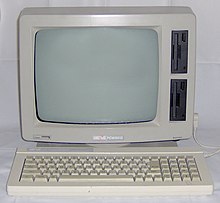Amstrad PCW
The Amstrad PCW / Joyce Schneider P ersonal C omputer for W ord Processing was as a writing system and CP / M offered -Bürocomputer, as a complete package with monitor, disk drives and printers.
For a long time it was an inexpensive 8-bit competitor to the IBM PC , and in addition to the actual LocoScript word processor supplied (from Locomotive), the extensive CP / M-Plus software offer was available. Mallard BASIC (from Locomotive Software ; see Locomotive BASIC ) and DrLogo ( Digital Research ) were already included as programming languages . There were also office applications for desktop publishing, databases and calculations. The costs for such a complete LocoScript system were usually lower than the purchase price only for the software of the competition.
While the Amstrad PCW was also used as a universal office computer in Great Britain for a long time, it was marketed and used as a writing system in Germany. The project name Joyce (after the secretary of Alan Sugar , the founder of Amstrad) was retained by Schneider .
Furnishing
Depending on the series and retrofitting, 256 kB RAM were initially available, later 512 kB and more memory. A green and black monitor was delivered, later a black and white monitor. The computer itself was predominantly integrated with the drives in the monitor housing , similar to the original Mac or Canon Cat , but in one series the PC desktop design was copied . When drives were e.g. Partly next to each other, the following types installed:
- 3 ″
- 3 ″ for floppy disks with extended storage space (720 kB)
- 5.25 ″
- 3.5 ″
- Hard disk (optional)
The 3 "memory format was not compatible with that of the Schneider CPC , special software helped (later). A data exchange via a kind of parallel port null modem was possible without any problems.
With the PCW you could use the computer directly as a typewriter in a special mode. With the last PCW, the type 16, an office software package comparable to the Amstrad NC100 was given instead of LocoScript .
An optionally available adapter was required to connect a regular Centronics printer. In addition to the supplied needle, inkjet and type wheel printers, it was also possible to connect a laser printer.
The PCW was quite popular and well known in the UK. The users included a. former Prime Minister John Major , and the PCW was also used in the Doctor Who television series . In Germany there is still a small computer scene that focuses on the Joyce User AG and the annual Spectra-Joyce meeting.
Series
- PCW 8256 , 1985, known as Joyce , 256 kB RAM, a 3 ″ drive (for floppy disks of 170 kB per side, which had to be turned over), was mostly written with Tasword 8000
- PCW 8512 , 1985, known as Joyce Plus , 512 kB RAM, two 3 "drives (with an additional drive for floppy disks of 720 kB that did not need to be turned), was mostly written with Tasword 8000
- PCW 9512 , 1987, 512 kB RAM, 3 "drive
- PCW 9256 , 1991, 256 kB RAM, 3½ "drive for floppy disks with a capacity of 720 kB and Locoscript 1
- PCW 9512plus , 1991, 512 kB RAM, 3½ "drive
- PCW 10 , 1993 (press only)
- PCW 16 , 1996, also known as Anne
In addition, there were clones or conversions by other companies, such as the British company Isenstein , etc. a. with black housing or in portable pilot case format.
operating system
Operating system of Joyce was CP / M . Since memory locations in the main memory (RAM) could only be addressed with 2 bytes, the main memory was divided into so-called "banks" of 64 kilobytes each, between which the operating system switched. It was also possible to program assembler programs. From 1987 to 1989 PC International published four Joyce specials in which the scene exchanged information about the operating system and self-designed programs for the Joyce (including assembler programs).
Games
Although the device was intended for office work, you could, due to the Zilog Z80 processor used, basically use all the other software that was already available and thus also use the PCW for games. In addition to the popular text adventures , there was graphic entertainment such as Batman and Head Over Heels .
literature
- Holger Dillin, Hardy Strassenburg: The Data Becker Guide: JOYCE - Everything at a Glance , Düsseldorf 198 ?, ISBN 3-89011-403-2
Emulators
Web links
- 21 things about the PCW
- FAQ page about FAQ on the topic
- Joyce - more than a text system 1
- Joyce - more than a text system 2
- Joyce service manual, repair and assembly
- Word processor Tasword 8000 (CP / M)
Individual evidence
- ^ DMV-Verlag, Eschwege. The same publisher's PC International magazine also published programs for the Joyce during these years.
- ^ Great games on a word processor

